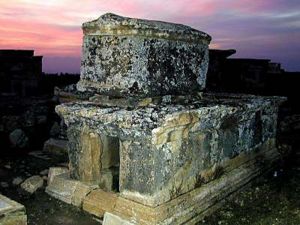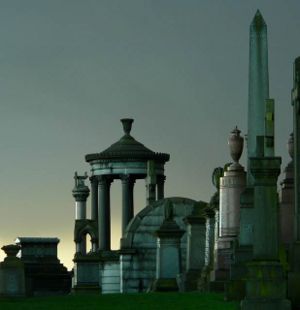Cemetery 53,55: Difference between revisions
Giles Sednik (talk | contribs) (unmerging) |
No edit summary |
||
| (One intermediate revision by one other user not shown) | |||
| Line 12: | Line 12: | ||
S_location=[[Dorey Walk|Dorey Walk]]|S_color=Street| | S_location=[[Dorey Walk|Dorey Walk]]|S_color=Street| | ||
SE_location=[[Wasteland 54,56|wasteland]]|SE_color=Wasteland}} | SE_location=[[Wasteland 54,56|wasteland]]|SE_color=Wasteland}} | ||
===Description=== | ===Description=== | ||
[[Image:Necropolis_sarcophagus.jpg|thumb|left|300px|The ancient sarcophagi still baffle ancient professors.]] | |||
Very nearly the most central cemetery in Malton (second only to [[Cemetery 45,49|this one]] in [[Barrville]]), this is without doubt the oldest and most historically interesting. | |||
===History=== | ===History=== | ||
Ancient historians of ancient history have repeatedly debated the origins of this necropolis, which predates any known settlements in the Old Malton area, and even Greater Maltonshire as a whole. Some of the sarcophagi appeared to date as far back as 10,000BCE, which would make them contemporaneous with the Hittite civilization of Asian Minor. Cuneiform runic inscriptions found on the side of these gargantuan tombs have been used to imply a link between the two far-distant cultures, or with the later Norse cultures. | |||
Although no-one has been able to translate the runes fully, they appear to refer to a mystic land known as '''Barhahra''', possibly a precursor of Valhalla, inhabited by a race of giants who gained superhuman strength by drinking blood and eating the flesh of their vanquished foes. The tombs themselves are of truly epic scale, but archaeologists and engineers were unable to devise a safe way of removing the staggeringly heavy slabs to reveal what might lie inside. Seismic surveys suggest that the tombs may extend some way underground, with lined chambers and tunnels below the tombs. | |||
[[Image:Necropolis-lst035517.jpg|thumb|right|300px|The 19th century tombs took a variety of forms.]]<br> | |||
[[ | In the 19th century, the necropolis was expanded by wealthy [[Stanbury Village]]rs, who found the massive tombs appealingly Gothic and Romantic. The 19th century monuments are grand in their own right, but dwarfed by the ancient ones in the cemetery's heart. Notable locals buried here include [[The_Kersley_Family|Appolonius Kersley]], [[the Sprackett Building|Dame Sprackett]] and [[Bently_Towers|Braithwaite Bently]]. | ||
[[ | |||
Latest revision as of 21:52, 28 December 2009
| a cemetery
Stanbury Village [53,55]
Basic Info:
|
Description
Very nearly the most central cemetery in Malton (second only to this one in Barrville), this is without doubt the oldest and most historically interesting.
History
Ancient historians of ancient history have repeatedly debated the origins of this necropolis, which predates any known settlements in the Old Malton area, and even Greater Maltonshire as a whole. Some of the sarcophagi appeared to date as far back as 10,000BCE, which would make them contemporaneous with the Hittite civilization of Asian Minor. Cuneiform runic inscriptions found on the side of these gargantuan tombs have been used to imply a link between the two far-distant cultures, or with the later Norse cultures.
Although no-one has been able to translate the runes fully, they appear to refer to a mystic land known as Barhahra, possibly a precursor of Valhalla, inhabited by a race of giants who gained superhuman strength by drinking blood and eating the flesh of their vanquished foes. The tombs themselves are of truly epic scale, but archaeologists and engineers were unable to devise a safe way of removing the staggeringly heavy slabs to reveal what might lie inside. Seismic surveys suggest that the tombs may extend some way underground, with lined chambers and tunnels below the tombs.
In the 19th century, the necropolis was expanded by wealthy Stanbury Villagers, who found the massive tombs appealingly Gothic and Romantic. The 19th century monuments are grand in their own right, but dwarfed by the ancient ones in the cemetery's heart. Notable locals buried here include Appolonius Kersley, Dame Sprackett and Braithwaite Bently.

